| کد مقاله | کد نشریه | سال انتشار | مقاله انگلیسی | نسخه تمام متن |
|---|---|---|---|---|
| 6364368 | 1623068 | 2016 | 12 صفحه PDF | دانلود رایگان |

- A novel superparamagnetic Bi2O4/Fe3O4 was prepared by in-situ growth method.
- Bi2O4/Fe3O4 exhibits enhanced visible-light-driven photocatalytic activity.
- Surface modification of Fe3O4 facilitates the eâ-h+ pairs separation of Bi2O4.
- h+ plays the major role for the degradation and mineralization of ibuprofen.
- Bi2O4/Fe3O4 can be magnetically recycled and shows good reusability potential.
Ibuprofen (IBU) is one of the representative persistent organic pollutants (POPs) which can cause severe adverse effects in humans and wildlife. Therefore, effectively removing IBU from water is a worldwide necessity. In this study, a novel superparamagnetic Bi2O4/Fe3O4 nanocomposite was successfully prepared by an in-situ growth method and utilized for photocatalytic removal of IBU. The structural characterization of the Bi2O4/Fe3O4 nanocomposite indicates that the monodisperse Fe3O4 nanoparticles of diameter 10Â nm are highly assembled on the Bi2O4 nanorods of diameter 120Â nm. Under visible light irradiation, using an optimum molar ratio of Bi2O4/Fe3O4 (1:2.5) resulted in a complete photocatalytic degradation of IBU within 2Â h, which is a 1.7 times higher efficiency than pure Bi2O4, and a complete mineralization of IBU with a prolonged irradiation time of 4Â h. In addition, the potential practicality of Bi2O4/Fe3O4 (1:2.5) was also demonstrated by the efficient photocatalytic degradation of IBU in actual drinking water. The photocatalytic mechanisms of Bi2O4/Fe3O4 (1:2.5) were revealed, indicating that the enhanced photocatalytic performance was mainly attributed to the accelerated separation of electron-hole pairs after surface modification of Fe3O4, and that the photogenerated h+ was the primary reactive species for the photocatalytic removal of IBU. Furthermore, the Bi2O4/Fe3O4 (1:2.5) can be magnetically recycled and shows good reusability without significant loss of photocatalytic activity or structural change even after reuse over five cycles, showing a promising application for the photocatalytic degradation of POPs from water.
167
Journal: Water Research - Volume 100, 1 September 2016, Pages 393-404